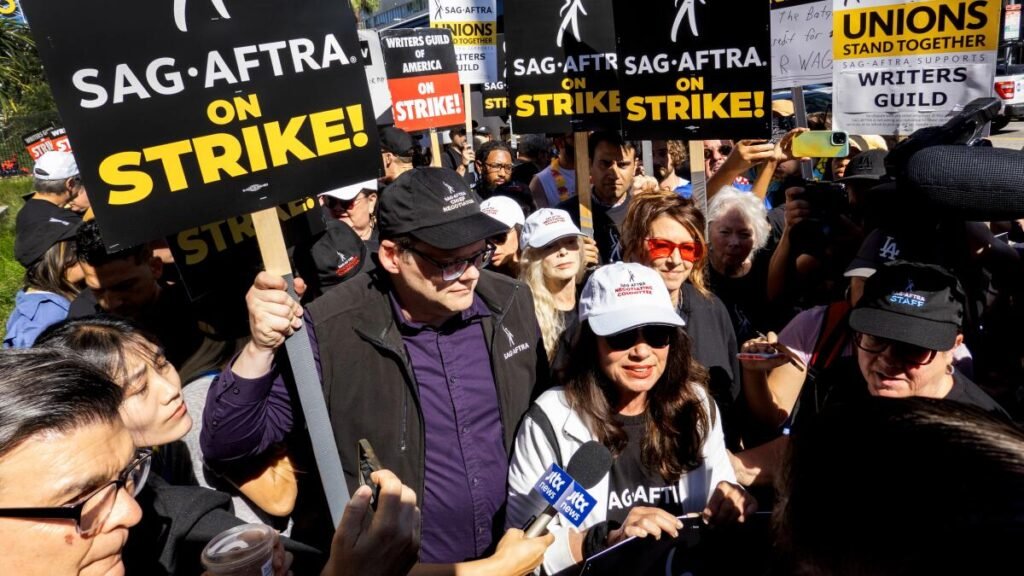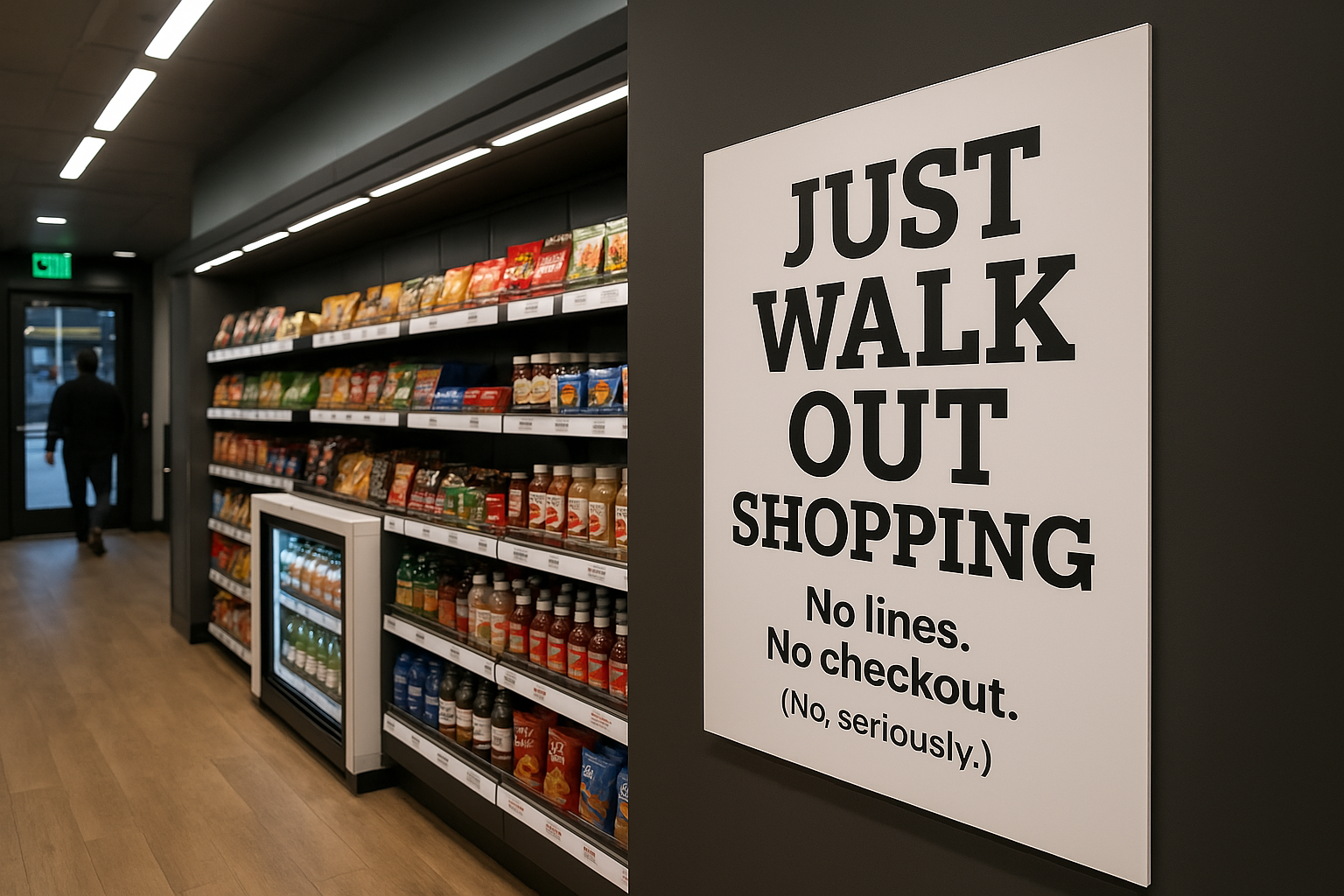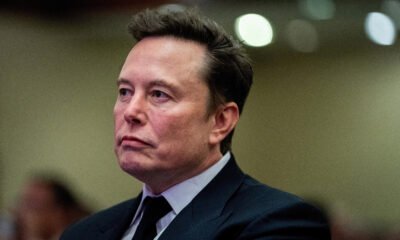Business
Autonomous Driving in Question as Tesla Recall Two Million Vehicles
Published
1 year agoon

Tesla, the innovative electric car giant led by billionaire Elon Musk, is facing a significant challenge as it recalls nearly all vehicles sold in the United States. This move comes after a two-year investigation into crashes related to Tesla’s driver assistance system, Autopilot, which has been found to be partly defective. In this article, we delve into the details of the Tesla recall, shedding light on Autopilot defects, the broader landscape of Driver Assistance Technology, concerns about Autonomous Vehicle Safety, and the potential Tesla Stock Impact.
Tesla Recall Overview
The recent recall impacts almost every Tesla vehicle sold in the US since the launch of the Autopilot feature in 2015. The recall involves addressing defects in the Autosteer component of Autopilot, which is designed to assist with lane-keeping in conjunction with traffic-aware cruise control. Notably, Tesla plans to remedy the issue through an over-the-air software update, reflecting the company’s commitment to addressing concerns without requiring a physical visit to dealerships.
Autopilot Defects
The defects in Tesla’s Autopilot system have been a focal point of the recall. Autopilot, despite its name, still requires driver input, and the US National Highway Traffic Safety Administration (NHTSA) found that the controls’ prominence and scope may not be sufficient to prevent driver misuse. The recall emphasizes the need for additional checks on turning on the self-driving features and aims to enhance the feature’s controls to avoid misuse.
Driver Assistance Technology
Autopilot is a prime example of Driver Assistance Technology, designed to aid drivers in steering, acceleration, and braking. However, the recall highlights concerns about the responsible deployment of such technology. The NHTSA’s findings underscore the importance of ensuring that the technology is used responsibly and only in appropriate conditions, such as highway driving. The recall’s focus on additional alerts and monitoring reflects an effort to encourage responsible driver behavior when Autosteer is engaged.
Also Read: See How The Nations Are Grappling with the Unpredictable Dangers of AI
Tesla Recall Underscores Autonomous Vehicle Safety
The safety of autonomous vehicles, a key aspect of Tesla’s vision, is under scrutiny with this recall. While Tesla defends the safety of Autopilot, the NHTSA’s investigation raises questions about the technology’s readiness. Critics argue that Tesla has misled customers about the software’s capabilities, contributing to risks. The recall aims to enhance safety metrics and prevent misuse, but experts highlight the opportunity missed for stricter regulatory measures to limit Autopilot features in certain circumstances.
Automotive Researchers’ Perspective
Philip Koopman, an automotive safety researcher and associate professor of computer engineering at Carnegie Mellon University, offers valuable insights into Tesla’s recent recall. In an email to CNBC, Koopman acknowledges that the recall has the potential to reduce misuse on unsuitable roads, thereby preventing some crashes. However, he highlights key aspects where the voluntary recall falls short in terms of ensuring comprehensive safety measures.
Koopman emphasizes the absence of a “definitive, measurable outcome promised” in the recall. He points out that other manufacturers commit to allowing their driver assistance systems only on approved roads, a commitment lacking in Tesla’s recall initiative. This observation raises questions about the effectiveness of the recall without clear benchmarks for safety improvements.
One notable gap identified by Koopman is Tesla’s reluctance to retrofit cameras into older EV models lacking this feature. Additionally, the absence of a commitment to retrofit night vision into existing cameras poses challenges to robust driver monitoring. Koopman suggests that the in-cabin cameras in Tesla vehicles, while serving as driver monitoring systems, may not be sufficiently robust to ensure safe operation.
Erik Vinkhuyzen, a visiting researcher at King’s College London and another automotive safety expert, adds to the discourse. Vinkhuyzen expresses skepticism about the efficacy of additional alarms prompting drivers to pay attention, deeming them “unlikely to help much.” He emphasizes the inadequacy of efforts to force drivers to pay attention, especially considering Tesla’s rhetoric that the software is approaching autonomy and full self-driving capabilities.
According to Vinkhuyzen, the real remedy lies in making drivers actively participate in the driving task. He proposes that if drivers need to steer, they will naturally be compelled to pay attention. While Autopilot can still handle accelerating and braking, requiring driver engagement in steering ensures a safer driving experience. Vinkhuyzen highlights the risk of Autosteer lulling Tesla owners into a false sense of having a self-driving car, leading to distractions like reading emails or even falling asleep.
Incorporating these expert perspectives underscores the complexities surrounding Tesla’s recall and the measures needed to ensure the safety and responsible use of driver assistance technologies. The insights provided by Koopman and Vinkhuyzen contribute to the ongoing dialogue about the recall’s efficacy and the broader challenges associated with autonomous driving technology.
Also Read: Elon Musk Optimistic as Tesla Cybertruck Set for Highly Anticipated Launch
Tesla Stock Impact
Tesla’s stock is experiencing fluctuations in the wake of the recall, but industry experts believe that the recall alone is unlikely to significantly impact the company’s momentum. Susannah Streeter of investment company Hargreaves Lansdown notes that recalls are not uncommon in the automotive industry, and Tesla’s financial strength enables investments in fixes. Despite this, concerns about Autonomous Vehicle Safety and Autopilot defects may have implications for Tesla’s stock value.
Conclusion
In conclusion, Tesla’s recall of nearly all vehicles in the US underscores the challenges and responsibilities associated with advancing autonomous driving technology. Autopilot defects, concerns about Driver Assistance Technology, and the impact on Tesla’s stock value all contribute to a complex narrative. As Tesla addresses the recall through software updates, the broader conversation around Autonomous Vehicle Safety and the role of driver assistance technologies continues. The evolution of these technologies will likely shape the future of the automotive industry, emphasizing the need for responsible development and deployment.
Sahil Sachdeva is an International award-winning serial entrepreneur and founder of Level Up PR. With an unmatched reputation in the PR industry, Sahil builds elite personal brands by securing placements in top-tier press, podcasts, and TV to increase brand exposure, revenue growth, and talent retention. His charismatic and results-driven approach has made him a go-to expert for businesses looking to take their branding to the next level.

Business
Cottagecore 2.0: The Return of Cozy, Nature-Inspired Living in 2025
Published
10 hours agoon
April 14, 2025
Remember the Cottagecore trend that took over Instagram and TikTok a few years ago? Well, it’s back—but with a modern twist. Dubbed Cottagecore 2.0, this lifestyle movement is gaining momentum in 2025, with more people embracing rustic aesthetics, sustainable living, and cozy, handcrafted home décor. From celebrities to influencers, many are turning their homes into nature-inspired sanctuaries, blending vintage charm with contemporary comforts.
What is Cottagecore 2.0?
The original Cottagecore aesthetic celebrated a romanticized rural lifestyle—think floral dresses, vintage teacups, and hand-sewn quilts. However, the 2025 version of the trend incorporates:
- Smart Home Features in Rustic Spaces: Vintage aesthetics meet modern technology, with AI-powered fireplaces, automated greenhouses, and sustainable energy sources.
- Sustainable & Handmade Décor: More people are supporting local artisans and choosing upcycled, handcrafted furniture.
- Nature-Integrated Living: Urban dwellers are adding indoor gardens, hydroponic setups, and earthy color palettes to bring the outdoors in.
- DIY & Slow Living: From baking sourdough to knitting blankets, there’s a shift toward intentional, slower lifestyles.
Why is Cottagecore Trending Again?
- Escapism & Stress Relief: In today’s fast-paced digital world, people crave peaceful, nostalgic environments that allow them to slow down and disconnect. Cottagecore aesthetics offer that escape.
- Sustainability Movement: The growing focus on eco-friendly living has made rustic, upcycled décor and handmade goods more appealing than mass-produced alternatives.
- Social Media Influence: Platforms like TikTok and Instagram are flooded with home transformation videos showcasing cottage-style interiors, cozy reading nooks, and lush indoor gardens.
How to Embrace Cottagecore 2.0 in Your Home
-
Decorate with Earthy & Vintage Accents – Add rustic wooden furniture, floral wallpaper, antique mirrors, and cozy woven blankets.
- Bring Nature Indoors – Indoor plants, dried flowers, and herb gardens can instantly make a space feel warm and inviting.
- Embrace Handmade & DIY Projects – Try baking your own bread, learning embroidery, or upcycling thrifted furniture.
- Create a Cozy Reading Nook – A small corner with warm lighting, soft pillows, and bookshelves enhances the Cottagecore aesthetic.
Cottagecore 2.0 isn’t just about aesthetic trends—it’s a movement toward slower, mindful living in a world that often feels too fast. Whether it’s incorporating vintage décor or adopting a more self-sufficient lifestyle, this trend is shaping how people create cozy, meaningful spaces in 2025.
Business
SAG-AFTRA’s New Ad Deal Signals a Shift in Talent Rights
Published
15 hours agoon
April 14, 2025
After months of negotiation and growing tension behind closed doors, SAG-AFTRA and the advertising industry’s top players have finally reached a tentative agreement. This successor deal, aimed at replacing the old contracts governing how union performers work in commercials, could shape the future of advertising talent across the U.S. With the commercial world leaning more digital, and actors demanding better pay, protections, and transparency, this agreement is not just a handshake—it’s a shift in how labor and brand storytelling will coexist moving forward.
In the last few years, a silent tug-of-war has been unfolding in the world of commercial advertising. Actors wanted more than a line in a script—they wanted a fair share of the value they bring to campaigns. As influencers blur the lines between creators and performers, and AI tools creep into talent spaces, the existing contracts had started to feel more like relics than roadmaps.
Now, with this tentative agreement in place, there’s cautious optimism from both sides.
For advertisers, this deal promises stability. For performers, it signals progress. And for the entertainment industry at large, it’s a rare moment of collaboration in an otherwise labor-charged year.
SAG-AFTRA has been at the heart of nearly every major labor conversation in entertainment over the past 18 months. From strikes to streaming wars, the union has had to defend its members in an era where traditional roles are being rewritten. With AI-generated voices, digital doubles, and shrinking royalties, the talent pool has been pushing back, asking for updated rules that reflect new realities.

This tentative agreement doesn’t just patch up the old—it lays the foundation for what comes next. While full details are still under wraps, both parties have hinted at major updates in compensation models, residual structures, and digital usage rights. One likely change? Stronger guardrails around AI and how it can (or can’t) be used to replace human performers in advertising.
The commercial sector might not get the same press as blockbuster films or primetime series, but it’s a cornerstone of many actors’ incomes. A single ad campaign can sometimes pay more than a minor role in a streaming series. So when these contracts expire, it’s not just about creative freedom—it’s about financial survival for thousands of performers.
Advertisers, on the other hand, are navigating their own shift. With content demand at an all-time high and consumers expecting authentic, diverse storytelling, the pressure to cast right—and do right by talent—has never been stronger. They need access to union talent, but they also need flexibility, speed, and budgets that make sense in an increasingly data-driven landscape.
That’s what makes this agreement so significant. It’s a signal that both sides are willing to adapt, innovate, and meet in the middle.
It also arrives at a time when brand messaging is under a microscope. Consumers are more tuned in to how brands behave behind the scenes. Ethical sourcing now includes talent treatment. A campaign with a great message but exploitative contracts? That doesn’t fly anymore. This deal, if ratified, could help brands stay on the right side of consumer trust.
The next step is ratification. Union members will get to vote on whether this agreement becomes official. While most expect it to pass, nothing is guaranteed. Union leadership has expressed strong support, signaling that the deal hits key demands. But performers are more informed—and more vocal—than ever before. They’ll read the fine print. They’ll ask tough questions.
And that’s a good thing. Because contracts that affect the creative economy should never be decided in silence.
As we wait for final approval, one thing is clear: this deal is more than a piece of paper. It’s a reflection of how talent, technology, and storytelling are colliding in the ad world. It shows that unions are still powerful when organized, and that advertisers are willing to evolve when the stakes are high.
In a year that’s been filled with division across industries, this tentative agreement offers a different narrative—one of cautious collaboration. And in the business of persuasion, maybe that’s the most powerful message of all.
Level Up Insight:
This agreement isn’t just about actors and ads—it’s about modern work. As industries digitize, human talent remains a brand’s strongest asset. Protecting it isn’t just ethical—it’s smart business. The brands that lead with fairness will be the ones that win both hearts and headlines.
Business
How Economic Uncertainty Pushes America Toward Recession
Published
4 days agoon
April 11, 2025
The Silent Trigger Behind Recessions: Why Uncertainty Can Shake America’s Strongest Economy
Every recession has its obvious culprits — stock market crashes, housing bubbles, banking failures, or trade wars. But there’s one quiet, invisible force that often sets the stage long before things officially collapse — economic uncertainty.
In today’s complex, interconnected U.S. economy, uncertainty works like a slow leak in a tire. It doesn’t cause the blowout immediately. But left unchecked, it drains confidence, delays spending, freezes investments — and eventually, brings even the biggest economies to a standstill.
As America faces rising concerns over inflation, interest rates, global conflicts, and changing government policies in 2025, experts are watching one metric more closely than ever — uncertainty. Because history shows: uncertainty isn’t just bad for business. It can quietly push an economy straight into recession.
What Exactly Is Economic Uncertainty?
Economic uncertainty simply means doubt about the future. Will inflation stay high? Will interest rates go up again? Will taxes change? Will a global conflict disrupt supply chains?
None of these things directly destroy the economy. But the fear of the unknown changes human behavior. Consumers stop spending. Companies stop hiring. Investors stop betting on the future.
When enough people pull back at the same time, growth slows, demand shrinks, and recession risks skyrocket.
How Consumers React When Confidence Drops
America runs on consumer spending. Nearly 70% of U.S. GDP comes from regular people shopping — buying cars, houses, clothes, groceries, vacations.
But uncertainty flips the switch on all of this.
If a family in Ohio worries about layoffs, or rising gas prices, or shrinking savings — they might skip buying that new car. A couple in Texas might delay their home purchase. Parents in California might cut back on weekend trips or restaurant outings.
Multiply this hesitation across millions of households — and suddenly retailers see declining sales, service industries suffer, and local businesses struggle to stay afloat.
That’s how uncertainty quietly kills demand.
Why Businesses Go Into Survival Mode
It’s not just consumers. Businesses hate uncertainty too — especially in America’s competitive environment where strategy depends on future planning.
Imagine a manufacturer in Detroit thinking of expanding a new factory. But rising tariffs, fluctuating raw material costs, and unclear tax policies make the future look risky.
Result? They delay the investment.
Same with tech startups in Silicon Valley unsure about future regulations around AI or data privacy. Or a restaurant chain unsure about wage policies in different states.
Instead of hiring more people or expanding, businesses hoard cash, cut spending, pause projects — preparing for the worst.
This delay in corporate decision-making slows growth long before any official “recession” arrives.
Financial Markets Feel It First
Wall Street is like America’s mood ring. The stock market doesn’t just react to current earnings — it reacts to future expectations.
High uncertainty triggers sell-offs, volatility spikes, and investor panic. In recent months of 2025, American markets have shown wild swings simply because the future feels foggy.
And when markets get shaky, people’s 401(k)s drop. Business valuations fall. Access to capital shrinks.
All of this flows right back to consumer confidence — creating a vicious cycle.
Tariffs, Policies & The Government’s Role
Economic uncertainty doesn’t always come from natural causes. Sometimes, it comes straight from government decisions.
In recent years, aggressive tariff policies, trade disputes, sudden tax reforms, and unpredictable regulatory moves have added fuel to America’s uncertainty fire.
Businesses today operate in a global ecosystem. Sudden import tariffs, like the ones proposed in 2025 on Chinese goods, don’t just hurt foreign companies — they hit American companies relying on those supply chains.
Without stable, predictable policy environments, uncertainty flourishes — and with it, the risk of recession grows.
The Domino Effect Nobody Talks About
Recession isn’t just about GDP contraction. It’s about people — their jobs, homes, families, and futures.
Uncertainty hurts small businesses first. Then it hits corporate earnings. Then jobs. Then entire industries.
And the worst part? The fear itself becomes contagious.
When people expect a recession, they start behaving like it’s already here — cutting back, hoarding cash, delaying everything. This collective hesitation turns fear into reality.
That’s why economists call uncertainty “the silent recession starter.”
Level Up Insight: The New Currency of Business is Clarity
In a world that’s moving faster than ever — uncertainty is everywhere. But the real winners in this economy won’t be the biggest or loudest players. They’ll be the clearest.
Whether you’re a startup founder, a small business owner, or an industry leader — your #1 job in uncertain times is to create clarity where others see confusion.
→ Be transparent with your team.
→ Be honest with your customers.
→ Build adaptable strategies, not fixed plans.
→ Invest in skills and systems that work in any market.
Because recessions don’t kill businesses — unpreparedness does.
America’s economy has survived wars, crashes, pandemics, and bubbles. It will survive uncertainty too.
But the next wave of industry leaders won’t be the ones waiting for clarity. They’ll be the ones creating it.
That’s how you Level Up when the world slows down.
Business
Meet the Mom Redefining Luxury Diaper Bags: Label The Muse Founder Saïka Bince Is Turning Motherhood Into a Fashion Statement
Published
4 days agoon
April 11, 2025
When Saïka Bince caught a glimpse of herself in the mirror while packing a diaper bag one morning, she didn’t just see a tired mom—she saw a muse gone missing. That fleeting moment sparked a quiet revolution. What began as an identity crisis bloomed into a couture movement. Today, she is the founder of Label The Muse, a luxury fashion brand out of Atlanta that’s transforming motherhood into a main-character moment.
Label The Muse isn’t just about handbags—it’s about visibility. Power. Presence. It’s about telling mothers: “You can carry bottles and still carry the room.” With signature pieces like the Bince Bag, a handcrafted marvel that takes over 80 hours to create, this designer diaper bag brand blends form and function into a love language that speaks directly to women who refuse to choose between elegance and everyday reality.
A Muse Born of Many Names
For Saïka, a first-generation Haitian American and mother, fashion has always been about legacy. Each bag in the Label The Muse collection is named after a matriarch in her family: Kesner (her grandmother), Ti Nette (her mother), and Bince (herself). These names aren’t just titles—they’re tributes. Embroidered into the brand’s DNA is a generational celebration of womanhood, sacrifice, and strength. These handbags are heirlooms in the making, designed not only to carry the essentials of motherhood but also its emotional lineage.
From Beauty to Boldness: The Journey of a Self-Taught Designer
Before founding Label The Muse, Saïka spent nearly a decade immersed in the beauty industry, where she created a makeup brand rooted in self-expression and personal transformation. Motherhood didn’t merely change her path—it expanded it. Feeling the tension between function and fashion, Saïka began sketching and sourcing materials with a clear vision: to create a diaper bag that didn’t erase her identity but elevated it.
She taught herself how to sew from scratch. Every stitch, clasp, and curve of her designs became a deliberate offering to the modern muse navigating nap schedules and personal ambition in the same breath.
The Bince Bag: Where Function Meets Fashion
Luxury diaper bags. Designer diaper bags. Vegan leather handbags. Label The Muse delivers all three and more. Each piece is constructed from bold, standout vegan leather and finished with soft gold-painted stainless steel hardware. Inside? Thoughtfully engineered compartments for diapers, electronics, bottles (double-insulated, of course), and even waterproof linings. Outside? Bold textures, artistic silhouettes, and couture-caliber polish.
This is what sets Label The Muse apart: They don’t design for “motherhood.” They are designed for mothers.
Legacy in Every Loop
More than a business, Label The Muse is a living archive—a fashion house preserving the elegance of Black motherhood, amplifying its voice, and redefining its aesthetic. Saïka is building an empire where beauty and burden aren’t at odds, but co-exist in every bag she creates. For her, being a mother didn’t mean losing herself. It meant expanding. Becoming not less—but more. The woman. The nurturer. The creative. The leader. The muse.
“Identity isn’t either/or—it’s and,” she says. “When you embrace every part of who you are, you don’t shrink. You become legacy.”
The Future Is Fashioned by Mothers
While the fashion world has long treated motherhood as an afterthought in fashion, Saïka sees it as a centerpiece. Her vision? A runway where baby bumps wear silk. Campaigns where softness is seen as a strength. Fashion houses that finally honor the women doing the most sacred work: creating life while staying entirely themselves.
And Label The Muse is just the beginning.
You can explore the full collection and learn more about the story behind Label The Muse by visiting the official website at www.labelthemuse.com.
Business
Why America’s Next Big Brands Are Starting From TikTok & Trailers, Not Boardrooms
Published
5 days agoon
April 10, 2025
America has changed the way it builds brands. The shiny glass boardrooms, the corporate pitches, the 10-year marketing plans — all of that belongs to an old world that Gen-Z doesn’t even care to remember. Today, the next wave of America’s most exciting brands is being born somewhere completely unexpected — on TikTok, inside 15-second trailers, filmed with nothing more than a phone and a little creativity.
And the crazy part? It’s working faster than anything the business world has seen before.
Across America, you’ll find small-town creators launching million-dollar brands right from their bedrooms. No VC funding. No MBA degree. No agency contracts. Just content, consistency, and a deep understanding of how people actually behave online.
This is America’s new branding revolution — not powered by big budgets, but by big attention.
Take a scroll through TikTok today, and you’ll see proof everywhere. A girl packaging her lip gloss orders by hand. A skincare founder sharing the story of how she battled acne. A small candle brand posting how they make each scent by hand in their garage. This is storytelling for the social age — raw, relatable, unfiltered. The audience doesn’t want to be sold a dream. They want to be part of the story.That’s why brands like Glow Recipe, Stanley Cups, Alix Earle’s collaborations, or even Scrub Daddy blew up. It wasn’t slick branding. It was real people talking about real products that fit into real life.
This is where TikTok is unbeatable — turning moments into movements.

But the strategy doesn’t stop at going viral. Smart American founders understand that virality is borrowed time. What lasts is community. What converts likes into lifetime customers is trust. And trust is built by showing up again and again — with authenticity.
That’s why the new-age American brand playbook looks like this:
→ Show the messy process, not just the final product.
→ Reply to comments like a friend, not a brand.
→ Post packaging videos, bloopers, fails, wins — all of it.
→ Make content that feels like a friend talking, not a company selling.
More importantly, America’s young founders are skipping the wait. No need for market research reports. The research is right there — in the comment section. Customers will tell you what works, what doesn’t, what they want next. Building on TikTok has become real-time branding. But of course, this journey isn’t without challenges. Trends die fast. The algorithm can love you one week and bury you the next. Competitors copy your product overnight. And cancel culture moves faster than any PR strategy can fix. That’s why building for speed is smart. But building for loyalty is essential. Brands that survive in America today do one thing really well — they listen. They treat every customer like a collaborator, every comment like feedback, and every video like a handshake. That’s why brands built on TikTok don’t feel like brands. They feel like friends hanging out in your feed.
Another massive shift? Founders themselves becoming the face of the brand. Consumers want to know who they’re buying from. Meet the maker. See their life. Know their struggles. Trust comes from transparency. That’s why a founder unboxing their own product hits harder than any commercial could. Even big American brands are adapting. Look at legacy companies rushing to look less corporate on social media. Replying with memes. Posting casual videos. Jumping on TikTok trends. Because they know — the next generation doesn’t care about polished perfection. They care about presence.
So what’s the real secret behind America’s new brand builders?
It’s simple. Content is brand. Brand is content. If you want to exist in the American consumer’s mind today — you need to exist in their feed every single day. Not by selling. But by showing up. Not by pushing. But by participating. This is the future of branding in America.
Where boardrooms are replaced by bedrooms. Where marketing plans are replaced by content calendars. Where product launches happen in trailers, not trade shows.
And most importantly, where consumers aren’t just customers — they’re your first community.
Level Up Insight:
“America’s next legendary brands won’t be remembered for their ads. They’ll be remembered for their moments. For showing up real. For building trust before transactions. And for turning TikTok trends into timeless loyalty.”
Business
America’s Boring Businesses Are Printing Millionaires
Published
6 days agoon
April 9, 2025
In a world obsessed with unicorn startups and viral apps, America’s quietest millionaires are coming from the most unexpected places. They don’t build social networks, create fancy software, or pitch to venture capitalists. Instead, they clean gutters, repair air conditioners, run laundromats, and own storage units. The businesses they operate are not glamorous, trendy, or disruptive. But they print money. And right now, across the United States, this wave of ‘boring business’ owners is quietly becoming one of the most profitable forces in modern entrepreneurship.
It’s the rise of the invisible millionaire. The operator who skips the hype, ignores the headlines, and focuses on what America will always need — essential services that keep life running.
While most of Silicon Valley stays busy chasing scale and valuations, a different America is building wealth in the slowest, simplest, and often dullest businesses imaginable. These are people who buy plumbing companies instead of launching apps, who run pest control businesses instead of social platforms, and who proudly own things like HVAC services or local car washes without worrying about going viral.
The new American business dream isn’t just about innovation. It’s about ownership.

For decades, boring businesses were ignored by most aspiring entrepreneurs. They were seen as blue-collar, small-time, or unscalable. But today, those same businesses have become some of the hottest assets in the U.S. economy. The reason is brutally simple — these businesses work. They work in good times and bad. They survive recessions. They don’t need crazy marketing budgets. And they deal in problems that never go out of style.
Every time an air conditioner breaks in the middle of a hot Texas summer, someone’s making money. Every time a basement floods in Ohio, someone’s cash register rings. Every time a small-town dentist retires, there’s an opportunity for a new owner to step in and take over a loyal customer base built over decades.
And smart money is noticing.
Private equity firms across America have quietly started to hunt these boring businesses like never before. What used to be fragmented, mom-and-pop industries are now prime targets for roll-ups, franchising, and regional domination. Groups of investors are buying up chains of laundromats, plumbing companies, and dental clinics — not to flip them for hype, but to hold them for cash flow.
America’s boring businesses are becoming America’s hottest assets.
The secret lies in their simplicity. These businesses aren’t at the mercy of tech disruption. Their customers aren’t looking for the next flashy alternative. A leaking roof or a clogged drain doesn’t care about the latest app or AI breakthrough. It needs fixing. Fast. And whoever controls that service controls real, lasting wealth.
But it’s not just big money getting involved. Across the U.S., a new generation of solo entrepreneurs, ex-corporate workers, veterans, and even immigrants are entering the boring business game. Many are skipping the startup route entirely. Instead of raising funds, they’re raising SBA loans — small business financing backed by the government. Instead of pitching investors, they’re pitching banks to acquire existing businesses with a proven track record of success.
These new operators are everywhere — quietly taking over Main Street America while the rest of the world scrolls social media.
And in the age of digital marketing, even boring businesses are becoming local powerhouses. A plumber in Michigan who knows how to dominate Google search results can turn a small operation into a regional empire. A cleaning service in Florida using smart Facebook ads can double its customer base without adding a single salesperson. Technology is no longer about creating something new. It’s about supercharging what already works.
America’s boring businesses thrive on trust, reputation, and repeat customers. And that’s a formula money will always chase.
Perhaps the most fascinating shift is cultural. For years, entrepreneurship in America was portrayed as a tech-driven, Silicon Valley fantasy. But today, the faces of wealth are changing. They look more like the guy who owns ten car washes across Indiana or the woman running multiple daycare centers in Tennessee. They aren’t chasing headlines. They’re chasing cash flow.
These new-age millionaires don’t care about being influencers. Their Instagram might be dead. Their LinkedIn might be quiet. But their bank accounts are loud.
Even exit strategies are smarter. Instead of gambling on an IPO or waiting for a big acquisition offer, boring business owners have real, tangible options. They can sell to competitors, pass the business to family, or hire operators to run it while they enjoy true passive income. It’s simple, clean, and profitable.
This is the new American dream — owning a boring business that never stops printing money.
It’s not glamorous. It’s not sexy. But it works.
And in a noisy world chasing the next big thing, that might just be the smartest strategy of all.
Level Up Insight:
America’s next great wealth wave isn’t coming from Silicon Valley. It’s rising from small-town service businesses, from dusty garages to family-owned laundromats. The boring business boom proves one timeless truth — ownership beats attention. While the world chases likes and followers, America’s new millionaires are chasing contracts, loyal customers, and recurring revenue. In the end, boring always wins. Quietly. Consistently. Forever.
Business
Community-Led Growth: How Small U.S. Brands Are Winning With Community Love
Published
7 days agoon
April 8, 2025
In America’s crowded marketplace, where algorithms dictate reach and ads flood every screen, a quiet revolution is happening. It doesn’t rely on million-dollar marketing budgets or celebrity endorsements. Instead, it thrives on trust, belonging, and a feeling no ad campaign can buy — community.
Across the U.S., small brands are realizing that before they can win wallets, they must first win hearts. And they’re doing it not through loud promotions but by building tight-knit communities around shared values, culture, and human connection.
This is the new growth story playing out on neighborhood streets, Discord servers, niche online forums, and even backyard events. The era of community-led growth isn’t just coming — it’s already here.
Why Community is Beating Traditional Marketing
In the past, brands could rely on perfect packaging, clever slogans, and mainstream media to win customers. Today’s consumers, especially Gen Z and millennials, demand something deeper — authenticity, interaction, and a sense of belonging.
This cultural shift has reshaped how smaller U.S. businesses approach growth. Instead of transactional relationships, they’re building emotional ones.
When people feel like part of a movement — not just buyers but contributors — loyalty skyrockets. The result? Organic word-of-mouth, unpaid ambassadors, and customer retention that big-budget ads can’t replicate.
Micro-Communities Are The New Powerhouses
Forget about follower counts or vanity metrics. The future belongs to brands that can cultivate micro-communities — small but fiercely engaged groups that genuinely care.
These communities could look like:
-
Private Facebook groups where customers share their personal stories.
-
Local meetups where product users bond over shared passions.
-
Digital spaces where fans co-create content or influence product decisions.
And the beauty? These spaces aren’t driven by the brand’s voice alone — they’re shaped by the community itself.
This decentralized approach makes customers feel valued, seen, and heard. And in the process, it transforms casual buyers into lifelong loyalists.

Experiences Over Advertisements
Today’s American consumer craves experience over exposure.
Pop-ups, workshops, collaborative events, and interactive campaigns are replacing sterile billboards. Small brands are investing more in real moments — whether that’s a casual coffee hangout, behind-the-scenes content, or surprise giveaways to loyal fans.
People remember how a brand made them feel — not what a static ad told them.
By showing up authentically in their customers’ lives, brands create stories worth retelling — and sharing.
The Power of User-Generated Content
One of the strongest drivers of community-led growth is user-generated content (UGC).
When customers create content on behalf of a brand — unprompted, unpaid — it speaks louder than any polished advertisement. It signals trust.
Brands fostering this environment aren’t just asking for reviews. They’re creating moments people want to share. This could mean:
-
Encouraging customers to post their stories
-
Re-sharing fan content
-
Letting users shape future product ideas
-
Hosting contests that spotlight real customer voices
UGC turns customers into creators — and creators into advocates.
Consistency Beats Virality
While viral moments are exciting, community-led brands focus on consistency over quick fame. They know the true growth lies in showing up day after day, delivering value, and nurturing their ecosystem.
Instead of chasing trends, they create them — within their communities first.
Growth becomes a byproduct of care, not clout.
America’s New Brand Builders Are Human, Not Corporate
Perhaps the most exciting shift in U.S. entrepreneurship is this: The face of the brand is often the founder or team itself.
People connect with people — not logos.
Whether it’s a founder sharing their messy startup journey, a team member doing live Q&As, or employees interacting directly in comments — brands that feel human win.
Authenticity is no longer optional. It’s the strategy.
Level Up Insight
The future of brand growth isn’t loud — it’s loyal. In America’s fast-changing landscape, small brands that lead with heart, honesty, and human connection will outlast those still shouting from billboards. Community-led growth isn’t just a marketing tactic — it’s the new currency of trust. And trust builds empires.
Business
Why America’s Small Businesses Are Scaling Like Startups
Published
1 week agoon
April 7, 2025
In the heart of Main Street America, a silent revolution is underway. The mom-and-pop shop, once a symbol of small-town charm, is evolving. The local bakery now runs Instagram ads. The hardware store ships nationwide through Shopify. The independent coffee brand is raising capital on Kickstarter.
This is not your grandfather’s small business model.
Across the United States, small businesses are thinking, operating, and growing like modern startups — fast, bold, and digital-first. The game has changed, and American entrepreneurs are playing it better than ever.
The data tells the story clearly. According to the U.S. Small Business Administration, over 33 million small businesses operate in America today, employing nearly half of the country’s workforce.
But what’s more fascinating is how these businesses are evolving. Technology has become the great equalizer. Tools once exclusive to Silicon Valley giants are now accessible to the florist in Florida or the personal trainer in Chicago.
Payment systems like Square. Marketing through TikTok and Meta Ads. Customer engagement via SMS tools like Klaviyo. Inventory powered by AI. Customer service handled by chatbots.
America’s smallest businesses now look dangerously close to its smartest.
Take for example, the rise of Direct-to-Consumer (DTC) brands coming from unexpected places. In towns like Austin, Nashville, and even Tulsa — local brands are building national audiences overnight.
A candle brand from Texas becomes a viral sensation on TikTok. A jewelry maker in Ohio lands a feature in Vogue. A fitness coach in Florida launches a $1 million course business from Instagram Reels.
These aren’t isolated cases. They’re signals.
America’s small business owners have realized one brutal truth: location no longer protects you from competition. Your customer can order from anyone, anywhere. If your bakery in Brooklyn isn’t on DoorDash, or your clothing line in LA isn’t optimized for Shopify — someone else will win that customer.
As a result, local businesses are adopting startup habits:
- Rapid prototyping new products
- Testing ads with small budgets
- Building brand presence online daily
- Outsourcing globally to stay lean
- Automating operations
- Leveraging creator partnerships
The small business playbook is looking suspiciously like a startup accelerator’s strategy deck.
But this evolution didn’t come without growing pains.
Many small business owners across America faced digital transformation out of sheer survival. The pandemic forced late adopters online. Supply chain issues demanded innovation. Rising advertising costs punished those without brand loyalty.
Yet, those who adapted are now reaping extraordinary benefits.
Remote teams? Normal now.
Subscription revenue? Common.
Crowdfunding launches? Expected.
Customer communities? Essential.
What was once considered Silicon Valley behavior is now standard practice from New York to Nebraska.

Even investors have caught on.
Traditional venture capitalists, once obsessed only with tech unicorns, are now funding product-first small businesses. Platforms like Kickstarter, Republic, and Shopify Capital have unlocked new ways for small brands to raise money without giving up control.
We are watching a new breed of American business rise — global in vision, digital in strategy, but local in heart.
More interestingly, consumers love this new small business energy. Shoppers today care about story, mission, and authenticity. They want to know who is behind the brand. And American small businesses are leaning into that transparency beautifully.
Behind-the-scenes TikToks. Founder-led podcasts. Instagram Live Q&As. Customer co-creation campaigns.
This human-first approach is winning hearts — and wallets.
Level Up Insight:
At Level Up, we believe the most powerful businesses of the future won’t just be built in boardrooms — they’ll be built in living rooms, garages, and local cafes.
America’s small businesses scaling like startups proves one undeniable fact: The size of your dream is no longer limited by the size of your store.
Tools are democratized. Attention is global. And creativity is the new capital.
This is not the death of small business — it’s the rebirth.
Faster. Sharper. Digital. Global.
Because in the new America — small is the new mighty.
Business
America’s Silent Retail Revolution: The Rise of the Cashierless Store
Published
2 weeks agoon
April 4, 2025
“No lines. No checkouts. No employees. Just walk out.”
What happens when the “human touch” is replaced by sensors, cameras, and artificial intelligence? In America’s retail scene, that future is no longer hypothetical—it’s already unfolding. From the heart of Manhattan to tech-forward hubs like Seattle and San Francisco, the cashierless store model is being rapidly adopted.
Once a novel experiment by Amazon Go, cashierless technology is now being piloted and scaled by retail giants such as Kroger, 7-Eleven, and even regional family-run chains. These next-gen stores are rewriting the playbook for retail: customers walk in, pick up what they need, and simply walk out. Payment is handled automatically via a connected app. There are no checkout counters. No clerks. No lines.
The idea sounds magical, almost futuristic—but it’s fast becoming mainstream. The real question now is: Is this the future of retail, or the death of human service as we know it?
How the Tech Works
At the heart of the cashierless concept is a fusion of advanced technology: computer vision, weight sensors, RFID tagging, and AI-driven analytics. As customers move through the store, overhead cameras and shelf sensors work in tandem to track every product interaction—when an item is picked up, put back, or carried out. Every movement feeds into a central AI system that updates the customer’s virtual cart in real-time.
Once the customer exits the store, their payment method is charged, and a digital receipt is sent within seconds. The entire process is frictionless, hyper-efficient, and, from a tech perspective, incredibly sophisticated.
Amazon was the pioneer—but now dozens of startups and logistics tech companies are racing to build plug-and-play cashierless solutions for retailers of all sizes.
Why Businesses Are Betting Big
The appeal is obvious. Traditional retail carries high fixed labor costs, slow checkouts, and inconsistent customer experiences. By contrast, cashierless stores promise:
- Up to 60% savings in labor costs
- Real-time inventory management
- Reduction in theft and shrinkage
- Data-rich consumer behavior tracking
- Faster turnover and more foot traffic
In Dallas, a mid-sized convenience chain piloted cashierless tech in three stores. The results? A 23% increase in revenue, 40% faster shopping times, and lower operating costs across the board.
It’s not just about eliminating jobs. It’s about rethinking space, design, and interaction. With no checkout counters needed, store layouts become more fluid, product placement becomes more strategic, and data-driven insights inform stocking decisions.

The Role of AI and Data
AI doesn’t just track products—it learns from them. These systems can detect buying patterns, recommend personalized promotions, and predict optimal product restocking. This kind of behavioral insight is gold for retailers who want to optimize profit per square foot.
For example, if AI sees that oat milk is selling more during mornings in one neighborhood, it can automatically adjust inventory and even suggest dynamic price shifts.
The Pushback and the Problem
Yet, for all its efficiency, cashierless retail is not without controversy.
Labor unions argue this is simply a sanitized form of mass layoffs. Retail jobs, especially entry-level cashier positions, are some of the most accessible employment opportunities in America. Their elimination has real social impact—particularly for young workers, seniors, and low-income communities.
There’s also the matter of digital exclusion. Not everyone has a smartphone. Not everyone trusts an app with their wallet. For elderly consumers, the technology may be intimidating. For the underbanked, it’s inaccessible.
And then comes data privacy. In a cashierless store, everything is tracked. Not just your purchases, but how long you look at a product, where you pause, and even what you almost buy. Is this acceptable consumer intelligence or invasive surveillance?
A 2024 survey by Pew Research found that 63% of Americans were uncomfortable with stores that track their behavior using facial recognition, even if it made checkout faster.
Global Impact and Scalability
Interestingly, the U.S. isn’t alone. Countries like China, Japan, and the Netherlands are also rolling out cashierless concepts. In fact, China’s BingoBox already runs over 500 cashierless mini-markets.
The scalability, however, depends on infrastructure, internet access, and cultural acceptance. In high-density urban areas, cashierless makes sense. But in rural America? The return on investment may not be as quick—or as welcomed.
The Middle Path: Hybrid Retail
Some businesses are opting for hybrid models—a mix of cashierless technology and human staff. This allows stores to offer high-speed convenience while still maintaining the warmth and support of face-to-face service for those who need it.
These models are also testing “tech-enabled assistants” where staff use handheld devices to assist older customers through the digital process, blending inclusivity with innovation.
Level Up Insight:
The rise of cashierless stores is not just a trend—it’s a signal of where retail is headed. But winning in this space won’t be about removing humans altogether. The smart businesses will blend automation with accessibility, using tech to enhance—not replace—the customer experience.
In the next five years, expect to see cashierless tech pop up not just in grocery stores, but in gyms, pharmacies, gas stations, and even pop-up shops.
For retailers, the message is clear: Evolve or risk becoming obsolete. For customers, the choice is more personal—speed or connection? Privacy or convenience?
The revolution is silent, but it’s everywhere.
Business
The New Pepsi Challenge: Saving Pepsi From Years of Decline
Published
2 weeks agoon
April 3, 2025
For decades, Pepsi has been one of the most recognizable brands in the world, a symbol of youth, rebellion, and pop culture. It has battled for market share, fought legendary ad wars, and been endorsed by the biggest celebrities. However, despite its strong legacy, the brand has struggled to maintain its dominance in recent years. Sales have been slipping, consumer preferences are shifting, and its identity is being questioned. The new challenge for Pepsi is no longer about beating its competitors—it’s about saving itself from an identity crisis and years of decline.
The Legacy of Pepsi and the Rise of Its Struggles
Pepsi has long positioned itself as the cool, youthful alternative to the more traditional choices in the market. Its marketing campaigns in the past focused on being bold, innovative, and in tune with younger generations. From partnering with pop stars to launching viral commercials, Pepsi thrived on cultural relevance.
However, as consumer trends evolved, so did the landscape of the beverage industry. The rise of health-conscious consumers has led to a decline in the consumption of sugary sodas. Consumers today are gravitating toward functional drinks, organic beverages, and zero-calorie alternatives. This shift has left traditional soda brands struggling to adapt, and Pepsi is no exception.
In addition, Pepsi has also suffered from inconsistent branding and marketing strategies. While it once had a clear identity, recent years have seen the company experimenting with various rebrands and campaign ideas that haven’t always resonated with the audience. In an age where brand loyalty is built on authenticity and purpose, Pepsi has struggled to establish a clear message that aligns with the values of today’s consumers.
The Rebranding Effort: Can Pepsi Revive Its Image?
To combat declining relevance, Pepsi has made multiple efforts to reinvent itself. The company has focused on bringing back a nostalgic appeal while trying to modernize its brand at the same time. However, these moves have had mixed results. While some nostalgia-driven campaigns have gained traction, they have not been enough to create long-term growth.
One of the major challenges Pepsi faces is redefining its core identity. Consumers today want more than just a drink—they seek a brand with values, purpose, and an emotional connection. Pepsi’s past marketing relied heavily on celebrities, but in today’s market, that is not always enough. Successful brands today engage deeply with their audience, standing for social issues, sustainability, and authenticity.
Pepsi’s recent packaging updates and marketing shifts have been an attempt to keep the brand fresh, but the question remains: Is this enough to make a real impact? While branding updates can create temporary buzz, they do not address the deeper issue of evolving consumer behavior.

A Shift in Consumer Preferences: The Health Factor
One of the most significant reasons for Pepsi’s decline is the growing awareness of health and wellness. More consumers are avoiding sugary drinks, opting instead for healthier alternatives like flavored water, natural energy drinks, and plant-based beverages. Pepsi has attempted to address this shift by expanding its portfolio to include lower-sugar and diet options. However, these efforts have not been aggressive enough to counteract the overall decline in soda consumption.
The challenge for Pepsi is not just in offering alternatives but in changing public perception. Many consumers still associate the brand with sugary, high-calorie sodas, despite its efforts to introduce “better-for-you” options. To truly win back consumers, Pepsi needs to go beyond product expansion and invest in educating its audience about its healthier innovations.
The Marketing Challenge: Staying Relevant in a Digital Age
Marketing has evolved drastically in the past decade. While traditional advertisements still play a role, modern consumers engage more with brands through digital platforms, influencer collaborations, and interactive experiences. Pepsi has attempted to keep up with these trends, launching social media campaigns and interactive experiences. However, its execution has not always been as effective as expected.
In today’s era, viral moments are crucial, but they must feel genuine. Consumers are quick to call out marketing that feels forced or inauthentic. Pepsi’s challenge is to find a way to create campaigns that not only grab attention but also align with the deeper values and interests of its audience.
What’s Next for Pepsi?
To truly turn things around, Pepsi needs a comprehensive strategy that goes beyond temporary fixes. A long-term vision for the brand should focus on the following key areas:
-
A Clear Brand Identity – Pepsi must redefine its core message. Instead of chasing trends, it should establish a solid brand identity that aligns with the values of modern consumers. Whether it’s health-conscious choices, sustainability, or a stronger cultural movement, Pepsi needs a purpose that resonates.
-
A Healthier Product Lineup – While Pepsi has introduced diet and zero-sugar options, it needs to innovate further in the beverage space. Functional drinks, energy-boosting beverages, and wellness-focused options could help reposition Pepsi as a brand that caters to the new generation.
-
Authentic Marketing & Digital Engagement – The brand needs to move beyond traditional celebrity endorsements and focus on authentic connections. Collaborating with social causes, engaging with grassroots communities, and using digital platforms effectively can help rebuild Pepsi’s cultural relevance.
-
Sustainability & Ethical Branding – Consumers today care about sustainability. Pepsi’s future success could depend on how well it embraces eco-friendly practices, from packaging innovations to carbon footprint reduction.
The New Pepsi Challenge: Will It Succeed?
Pepsi’s biggest challenge isn’t just about increasing sales; it’s about rebuilding its brand in a world where consumers demand more from the companies they support. The old Pepsi Challenge was about taste tests, but the new Pepsi Challenge is about proving its relevance, purpose, and commitment to the changing world.
If Pepsi can successfully adapt to these shifts—without losing sight of its core essence—it has a chance to reclaim its place as a dominant force in the industry. But if it continues with short-term marketing gimmicks and inconsistent messaging, it risks fading further into obscurity.
The future of Pepsi depends on its ability to take bold steps, not just in branding but in action. The world is changing, and if Pepsi wants to remain a part of it, it must rise to the challenge—now more than ever.
Trending
-

 Health4 years ago
Health4 years agoEva Savagiou Finally Breaks Her Silence About Online Bullying On TikTok
-

 Health3 years ago
Health3 years agoTraumatone Returns With A New EP – Hereafter
-

 Health3 years ago
Health3 years agoTop 5 Influencers Accounts To Watch In 2022
-

 Fashion4 years ago
Fashion4 years agoNatalie Schramboeck – Influencing People Through A Cultural Touch
-

 Fashion4 years ago
Fashion4 years agoThe Tattoo Heretic: Kirby van Beek’s Idea Of Shadow And Bone
-

 Fashion8 years ago
Fashion8 years ago9 Celebrities who have spoken out about being photoshopped
-

 Health4 years ago
Health4 years agoTop 12 Rising Artists To Watch In 2021
-

 Health4 years ago
Health4 years agoBrooke Casey Inspiring People Through Her Message With Music
-

 Tech2 years ago
Tech2 years agoGoogle Developer Conference to Unveil Latest AI Updates, Including PaLM 2 Language Model
-

 Health4 years ago
Health4 years agoTop 10 Influencers To Follow This 2021






